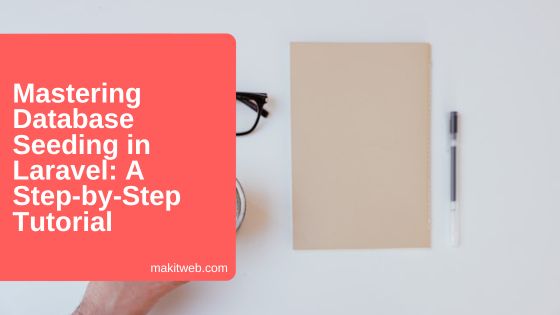Database seeding in Laravel is an essential process that facilitates the insertion of dummy or sample data into a database.
The purpose of seeding is to streamline development by eliminating the need to write individual SQL statements for populating database tables. Laravel offers a convenient method to create and maintain seeder files.
One significant advantage of database seeding is the ability to test an application without entering real data. By populating the database with mock information, developers can ensure the proper functioning of their code.
This article presents a step-by-step guide on how to create and execute a seed file in Laravel 10.

Table of Content
- Database Configuration
- Create Tables
- Create Model
- Create Seeding files
- Insert data to Tables using Seeder
- Run seeders
- Output
- Conclusion
1. Database Configuration
Open .env file.
Specify the host, database name, username, and password.
DB_CONNECTION=mysql DB_HOST=127.0.0.1 DB_PORT=3306 DB_DATABASE=tutorial DB_USERNAME=root DB_PASSWORD=
2. Create Tables
Creating 2 tables to insert dummy data using seeder –
- employees
- products
employees Table –
- Create
employeestable using migration –
php artisan make:migration create_employees_table
- Now, navigate to
database/migrations/folder from the project root. - Find a PHP file that ends with
create_employees_tableand open it. - Define the table structure in the
up()method.
public function up()
{
Schema::create('employees', function (Blueprint $table) {
$table->bigIncrements('id');
$table->string('username');
$table->string('name');
$table->string('email');
$table->string('gender',10);
$table->smallInteger('status')
$table->timestamps();
});
}
products Table –
- Create
productstable –
php artisan make:migration create_products_table
- Now, navigate to
database/migrations/folder from the project root. - Find a PHP file that ends with
create_products_tableand open it. - Define the table structure in the
up()method.
public function up()
{
Schema::create('products', function (Blueprint $table) {
$table->bigIncrements('id');
$table->string('name');
$table->text('description');
$table->integer('quantity');
$table->smallInteger('status');
$table->timestamps();
});
}
- Run the migration –
php artisan migrate
3. Create Model
Create 2 Models –
- Employees
- Products
Employees Model
- Create
EmployeesModel.
php artisan make:model Employees
- Open
app/Models/Employees.phpfile. - Specify mass assignable Model attributes – username, name, email, gender, and status using the
$fillableproperty.
<?php
namespace App\Models;
use Illuminate\Database\Eloquent\Factories\HasFactory;
use Illuminate\Database\Eloquent\Model;
class Employees extends Model
{
use HasFactory;
protected $fillable = [
'username','name','email','gender','status'
];
}
Products Model
- Create
ProductsModel.
php artisan make:model Products
- Open
app/Models/Products.phpfile. - Specify mass assignable Model attributes – name, description, quantity, and status using the
$fillableproperty.
<?php
namespace App\Models;
use Illuminate\Database\Eloquent\Factories\HasFactory;
use Illuminate\Database\Eloquent\Model;
class Products extends Model
{
use HasFactory;
protected $fillable = [
'name','description','quantity','status'
];
}
4. Create Seeding files
To create seeder files use following command –
Syntax –
php artisan make:seeder [Seeder-name]
I am creating 2 seeder files –
- EmployeesSeeder
php artisan make:seeder EmployeesSeeder
- ProductsSeeder
php artisan make:seeder ProductsSeeder
Seeder files are created in the database/seeders folder.
5. Insert data to Tables using Seeder
EmployeesSeeder
- Open
database/seeders/EmployeesSeeder.phpfile. - Include
Illuminate\Support\Strto generate a random string. - Include
Illuminate\Support\Arrto pick a random value from Array. - Include
App\Models\Employees. - In
run()method write insert code. - I am using 2 ways to insert records in the
employeestable –- Predefined values.
- Generating random values. Using
Strto generate random value and assign them to the fields. Similarly, usingArrto pick random value from Array and assign it to the field.
<?php
namespace Database\Seeders;
use Illuminate\Database\Console\Seeds\WithoutModelEvents;
use Illuminate\Database\Seeder;
use Illuminate\Support\Str;
use Illuminate\Support\Arr;
use App\Models\Employees;
class EmployeesSeeder extends Seeder
{
/**
* Run the database seeds.
*
* @return void
*/
public function run()
{
// Insert predefined data
Employees::create([
'username' => 'yssyogesh',
'name' => 'Yogesh singh',
'email' => 'yogesh@makitweb.com',
'gender' => 'Male',
'status' => 1,
]);
// Insert random value in fields
Employees::create([
'username' => Str::random(10),
'name' => Str::random(10),
'email' => Str::random(10).'@makitweb.com',
'gender' => Arr::random(['Male','Female']),
'status' => 1
]);
Employees::create([
'username' => Str::random(10),
'name' => Str::random(10),
'email' => Str::random(10).'@makitweb.com',
'gender' => Arr::random(['Male','Female']),
'status' => 1
]);
}
}
ProductsSeeder
- Open
database/seeders/ProductsSeeder.phpfile. - Include
Illuminate\Support\Strto generate a random string. - Include
App\Models\Products. - Inserting 10 random records in the
productstable.
<?php
namespace Database\Seeders;
use Illuminate\Database\Console\Seeds\WithoutModelEvents;
use Illuminate\Database\Seeder;
use Illuminate\Support\Str;
use App\Models\Products ;
class ProductsSeeder extends Seeder
{
/**
* Run the database seeds.
*
* @return void
*/
public function run()
{
// Insert random 10 records
for($index=0;$index<10;$index++){
Products::create([
'name' => Str::random(10),
'description' => Str::random(10),
'quantity' => rand(10,100),
'status' => 1
]);
}
}
}
DatabaseSeeder
- This is by default Seeder.
- Using this to execute all seeders.
- Open
database/seeders/DatabaseSeeder.phpfile. - In
run()method mention Seeder class in$this->call();.
<?php
namespace Database\Seeders;
// use Illuminate\Database\Console\Seeds\WithoutModelEvents;
use Illuminate\Database\Seeder;
class DatabaseSeeder extends Seeder
{
/**
* Seed the application's database.
*
* @return void
*/
public function run()
{
$this->call([
ProductsSeeder::class,
EmployeesSeeder::class
]);
}
}
6. Run seeders
Run single seeder –
php artisan db:seed --class=EmployeesSeeder php artisan db:seed --class=ProductsSeeder
Using the above command you need to separately execute seeders one by one.
Run all seeders –
php artisan db:seed
NOTE – Only those seeder execute that are specified in
DatabaseSeeder.
7. Output
8. Conclusion
Laravel’s powerful database seeding feature streamlines the process of database population. Developers can quickly create and insert sample data into the database of their application using Laravel’s built-in seeding system, which is helpful for testing and development.
If you’re a Laravel developer, database seeding is a feature you should definitely explore and use.
In the example, I am using eloquent to insert records but you can also use DB.
